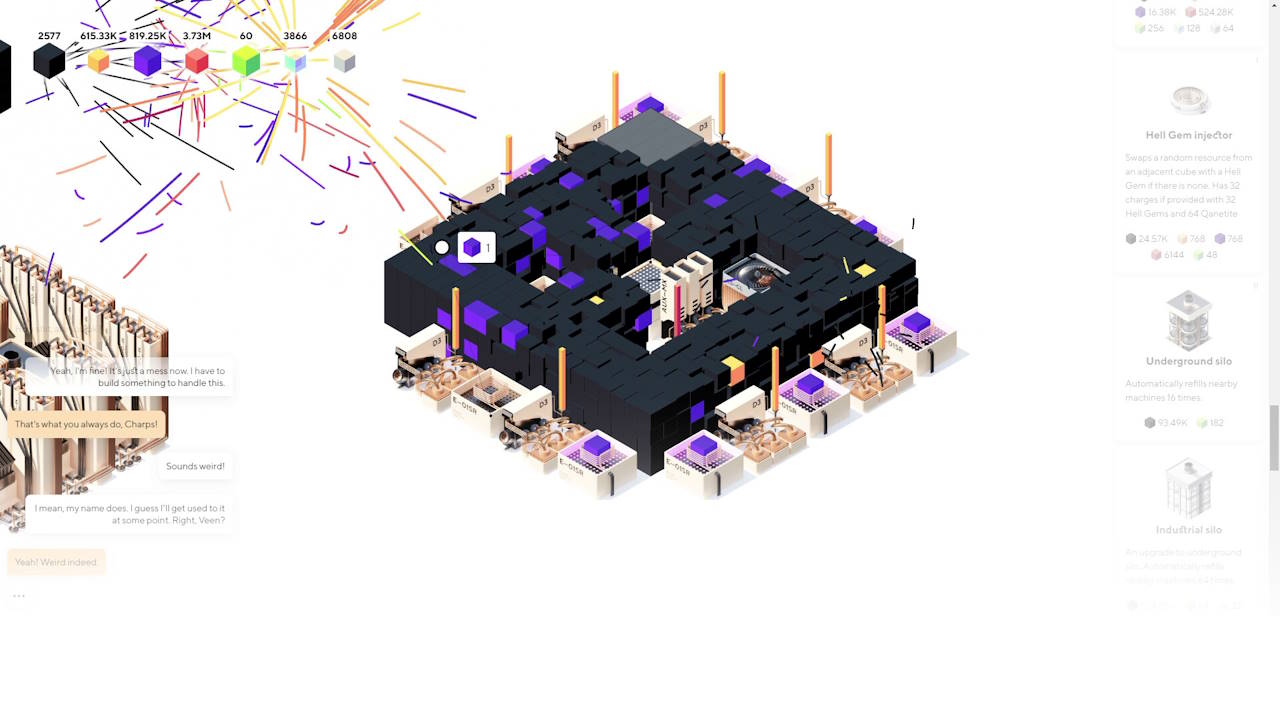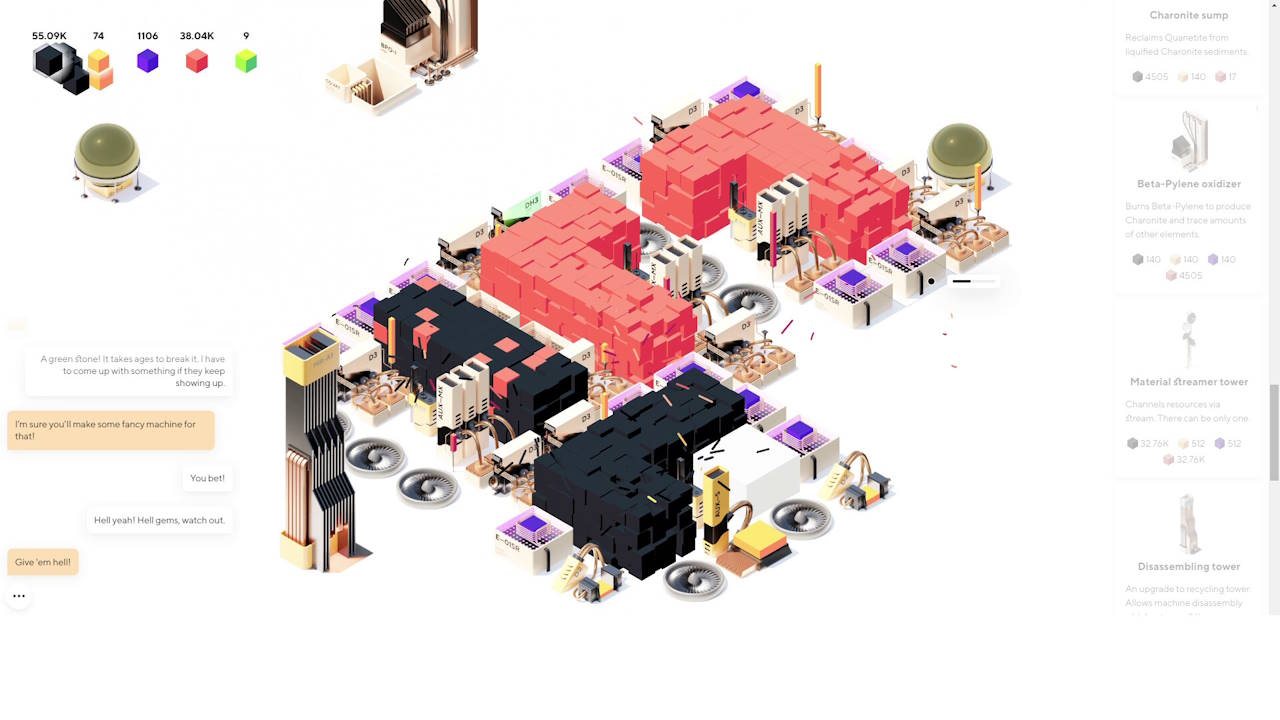March 4, 2024
Sixty Four by Oleg Danilov caught my attention for a number of reasons. A game where you build a factory from scratch is always a good start. Showing signs of automation, careful planning, and optimisation – heck, I’m excited now. Throw in a mysterious setting and frankly a game title that causes me to reminisce about one of the greatest YouTube videos of all time and I’m sold. But now with tens of hours in the bank playing Sixty Four, I find that initial enthusiasm has waned quite a bit.
The premise is fairly simple and understated. Before you stands a machine, which when activated produces black blocks that form in the eight compass directions around it. You can then click a few times on these large cubes to break them and then some of this black material – known as Charonite – is added to your inventory, tracked by a counter in the top left of the screen. This means the initial loop of Sixty Four is activating the central Extracting Channel for more Charonite to appear, and then using your mouse to chip away at it. As you earn more Charonite, you can pay for additional machines that can help you in your initial mining endeavour.
You’ll begin to unlock machines that will keep the Extracting Channel running for you, or speed up how quickly it produces the blocks, and after a while machines that can actually break the large blocks for you saving your clicker finger building up lactic acid. You also find additional helpful machines that add to the power of these block breakers. Before long you’ll be planning out the most strategic layout of each of these types of machines to allow space for the blocks to appear, and then be dealt with in as automated a way as possible. This leaves your focus on other matters.

And there are plenty of other matters to consider, as you’ll soon discover. After a while, the wholly black cubes of cubes become dotted with smaller cubes of yellow, or purple, representing Elmerine and Qanetite respectively. And with them comes the ability to power some of the previously mentioned machines but also requires more balancing of resources. You’ll unlock machines that spend a certain resource to make others to help you out, and you realise there’s a lot to Sixty Four in terms of scope and size, beyond what you initially thought.
Sixty Four tells you barely anything in terms of what to do, besides a brief description beneath each new unlocked machine that gives a clue as to its purpose in the great running of things. Alongside this is the story – as paper-thin as it is – told through yourself and another in the form of a text conversation happening in the bottom-left of your screen. You’re discussing how confused you are and you don’t know what any of this means, and over time you’re slowly figuring things out. Which is rather fitting really for the game as a whole.
But a hands-off game like this wouldn’t be so bad if there was a level of support or direction to assist the player in figuring out progression or indeed a quicker way towards it. A loose “next milestone” or target would have been helpful so you know which direction the game wants you to go. Sometimes progress is locked behind digging deep enough and uncovering a new colour of block, other times it relies on saving up to buy a brand-new type of machine. The problem is you’re never certain which it is and numerous times through my playthrough I thought progress was down one path only to find out it was another through sheer luck of natural expansion, and this can be very costly time-wise.

And time is something you’ll need a lot of given the production of materials happens at a set rate. Sure, there’s definitely optimisation that can be used to your advantage, but the game doesn’t seem to want to support or encourage it despite it being such an important facet of the game. There aren’t multiple save files, so you can’t experiment with a new configuration as a test, or even a sandbox test area to try a new layout. You can’t move placed machines either, it’s a cumbersome destroy-and-replace mechanic instead, which makes reorganising more hassle than it’s worth. And with the overlay of fearfully undoing your way to the next unknown progress step, you’ll tend to stick with what you have – inefficient or not. Even a simple “rate of production” for each resource – like something from a Total War title – would help you work out if a change you made was productive, but even that basic information is missing.
It’s telling as well that the story feed can often give clues as to what to do next but it can be cryptic. Despite the apparent “lack of knowledge” of our two conversationalists, they seem awfully lucky at guessing exactly what’s happening to the point I found myself going “Oh, that’s why that is happening – I’ve been wondering that for half an hour!”. So what you’ll likely find is progress is slow, and you don’t know if it’s because you’re inefficient, chasing after the wrong thing entirely, or if the game just takes that amount of time to progress, or a combination of all three. Either way, the fact it’s an idle clicker game without letting it be idle (or everything grinds to halt) means the gameplay is passive at best and becomes tedious and frustrating most of the time.
It would be remiss of me not to point out that I have spent over 30 hours with this game, and it wouldn’t be fair to say all of it was unenjoyable. The air of mystery the story creates, the feeling of the unknown created by the cold white backdrop, and a large mysterious rock forebodingly placed to the north awakens something in me. I want to know the story, what happens next, and what will I uncover. And when I do progress the story in a meaningful way it throws up more questions that certainly for the first half of the game, kept me going. But as the material cost for new machine became higher and higher, the gaps and lengths of passive gameplay became larger and that will test the patience of even the most enthusiastic gamer. If only the game helped you and guided you a bit more, I feel more people would end up seeing this story and game through to its conclusion. As it is, it’s difficult not to see most people falling off of it in confusion and annoyance.
Intriguing mystery
Some decent factory systems for optimisation
Depth comes with progression
No guidance on what to do next
Lack of support for optimisation or experimentation
Passive gameplay elements
Time taken to progress is far too long towards the end game
Sixty Four starts off well and its air of mystery is engaging, but a lack of guidance or support and lengthy time-sinks to progress will put most people off.





